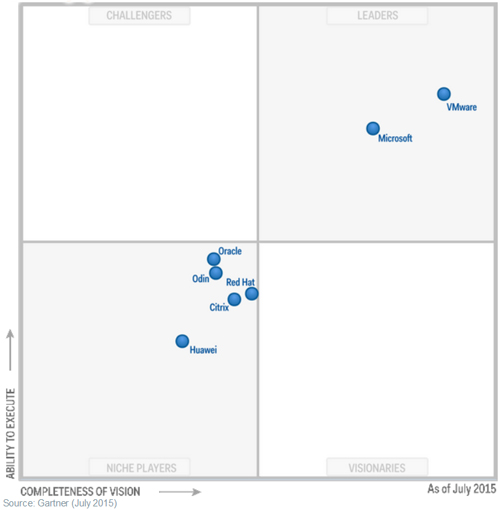News
Gartner: Microsoft Closing Gap with VMware in Virtualization
- By Keith Ward
- July 21, 2015
VMware and Microsoft are the two undisputed leaders in x86 server virtualization infrastructure, according to Gartner's 2015 "Magic Quadrant" report.
Released last week, this year's Gartner report looks a lot like the 2014 list, with VMware emerging as the clear leader and joined in the "Leaders" quadrant by only Microsoft.
 [Click on image for larger view.]
[Click on image for larger view.]
VMware was rated highest by a significant margin, ranking at the top for both "Completeness of Vision" and "Ability to Execute" (see image above). Microsoft was behind in both categories, but was still far ahead of the other five companies listed as important in server virtualization: Oracle, Odin, Red Hat, Citrix and Huawei. They had a place as "Niche Players."
VMware: Still King of the Hill
As part of its analysis, every Magic Quadrant report lists strengths and cautions for each vendor. Gartner is still bullish on VMware. "VMware continues to have dominant market share, and customers remain very satisfied with product capabilities and vendor support," the report stated, adding that the company is still growing at a healthy clip.
Despite those strengths, the report points out a number of challenges for VMware, and many come from Microsoft. "Client inquiries have been significantly increasing about comparisons between VMware and Hyper-V, specifically," Gartner said. In the SMB space, especially, Microsoft is becoming a threat: "[A]s Microsoft gains marketing momentum, VMware will need to continue to offer low-price packages to remain competitive in this market."
Another concern for VMware is its lack of traction in public cloud, which Gartner said could have large ramifications down the road. "While VMware has a dominant share for existing enterprise workloads, its share of the newer, cloud workloads is much smaller -- a major inhibitor to growth," the firm said.
On the whole, though, Gartner gives VMware high marks for its vision that extends virtualization from the datacenter to the cloud, strong technology and customer satisfaction.
Microsoft: A Solid Contender
In what should be considered a major victory for Redmond, Gartner said that Microsoft "has effectively closed most of the functionality gap with VMware in terms of the x86 server virtualization infrastructure." That's good news for companies whose virtualization efforts are newer or less entrenched, as it means there are more comparable options.
The issue then becomes one of saturation, as most shops have already put their server virtualization infrastructures in place. "Its challenge is neither feature nor functions, but competing in a market with an entrenched competitor, VMware," Gartner said. Microsoft is winning a "good" percentage of enterprises still implementing virtualization, the report states, but there aren't that many out there.
One area in which Microsoft still falls short of VMware is in its virtualization management tools, which Gartner said "have some ease-of-use weaknesses."
On the other hand, Microsoft has an advantage it's maintained since the early days when it made Hyper-V free: price. How much of an advantage this remains is a debatable question, but enterprises that have a large percentage of Windows workloads virtualized are the most likely to standardize on Hyper-V, since it's free.
Citrix: A New Direction
Citrix used to be in the "Leaders" quadrant, but has seen that position slip over the years to the point that Gartner now considers it a "Niche Player." The report this year has both good news and bad news. First, Gartner believes Citrix has thrown in the towel when it comes to the leaders. "[I]t is clear Citrix is no longer investing to keep up with market leaders VMware and Microsoft -- at least for traditional server virtualization in the data center," the report stated.
However, Gartner sees this less as a failing than a new direction, into cloud computing. From the report: "For cloud infrastructures, the Xen hypervisor will remain the most widely used architecture for public infrastructure as a service (IaaS) cloud providers, if for no other reason than it is used by Amazon Web Services." Gartner sees Citrix's goal as to grow its CloudPlatform business.
Since 2012, Gartner has downgraded Citrix on a consistent basis. It started as a "Leader," dropped to a "Visionary" in 2013, then tumbled again into the "Niche Player" category last year.
One interesting note is that Gartner estimates that "[a]bout 75% of x86 server workloads are virtualized," but adds that virtualization technologies "are becoming more lightweight." It doesn't specifically say so, but it would be safe to assume that containers, like Docker, is at least part of what Gartner means.
About the Author
Keith Ward is the editor in chief of Virtualization & Cloud Review. Follow him on Twitter @VirtReviewKeith.